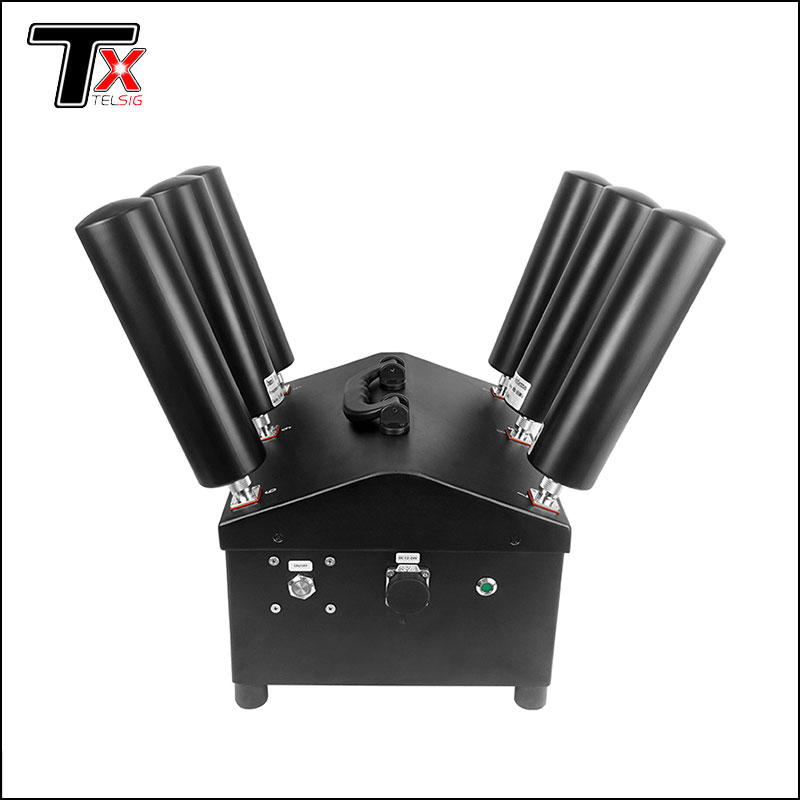Drone Jammer: The Growing Need for Anti-Drone Technology
2025-01-04
As drones continue to become more advanced and widely available, the concerns surrounding their potential misuse have grown. Whether it’s for criminal activities, spying, or violating privacy, the need for effective countermeasures has never been more urgent. One such solution gaining traction in both civilian and military sectors is the drone jammer—a device designed to disrupt and neutralize unwanted drone activity.
In this blog, we will explore what a drone jammer is, how it works, its applications, and the legal and ethical considerations surrounding its use.
What is a Drone Jammer?
A drone jammer is a device that uses radio frequency (RF) interference to disrupt the communication between a drone and its operator. By emitting powerful signals on the same frequency bands that drones typically use, these jammers can effectively "block" the drone’s control signals or GPS signals, rendering it uncontrollable or forcing it to return to its point of origin.
The technology behind drone jammers is similar to traditional jamming technologies used in military and security applications. However, the difference lies in the specific frequencies that are targeted and the precision required to safely and effectively neutralize a drone without causing broader interference in the surrounding environment.
How Does a Drone Jammer Work?
Drone jammers operate by disrupting the signals used for communication between the drone and its operator. These signals typically fall into two categories:
1. Control Signals (Radio Frequency Communication)
Drones are controlled by radio signals sent from a remote control device. A jammer can disrupt these signals, causing the drone to lose connection with the operator. In some cases, the drone will enter a "failsafe" mode and either hover in place or land automatically.
2. GPS Signals
Many drones rely on GPS for navigation and positioning. A drone jammer can interfere with the GPS signals, causing the drone to lose its ability to navigate accurately. This can either lead to the drone returning to its takeoff point or crashing to the ground if no other backup systems are in place.
The effectiveness of a drone jammer depends on various factors, including the range of the jammer, the type of drone being targeted, and the strength of the signals being jammed. Some advanced drone jammers even have the ability to block multiple frequency bands at once, making them more effective against a wide range of drones.
Applications of Drone Jammers
As drones have proliferated across industries, so too has the need for effective countermeasures. Drone jammers are being deployed in a variety of settings, including:
1. Military and Defense
One of the primary uses of drone jammers is in military applications. Drones have become a significant security threat on the battlefield, used for surveillance, reconnaissance, or even carrying explosives. Military forces use drone jammers to neutralize the threat posed by enemy drones. These jammers can disrupt the communication between the drone and its operator or interfere with the drone’s GPS signals, making it difficult for the enemy to carry out their missions.
2. Government and Law Enforcement
Governments and law enforcement agencies also use drone jammers to secure sensitive locations. For example, airports, prisons, military bases, and government buildings are vulnerable to drone incursions. Drones can be used to smuggle contraband, spy on officials, or conduct attacks. Drone jammers are deployed to prevent such illegal activities and protect national security.
3. Commercial Security
As drones have been used in a variety of commercial applications—ranging from photography to delivery services—there has been an increasing need for private companies to protect their assets from unauthorized drone surveillance or malicious activities. Security firms are using drone jammers to ensure that no drones can enter restricted airspace, especially in highly sensitive areas like factories, industrial complexes, or corporate headquarters.
4. Critical Infrastructure Protection
Drones can pose a serious risk to critical infrastructure such as power plants, dams, and oil refineries. Unauthorized drones can be used for surveillance, sabotage, or even terrorism. Using drone jammers helps protect these assets from potential threats by preventing drones from entering restricted zones.
5. Event Security
Large public gatherings, such as concerts, sports events, and political rallies, often attract drone enthusiasts or individuals with malicious intent. Drone jammers are deployed at these events to prevent drones from flying over the crowd, ensuring safety and privacy. By using jammers, event organizers can mitigate the risk of aerial surveillance or unwanted disruptions during high-profile events.
Legal and Ethical Considerations
While drone jammers provide a vital tool in protecting sensitive spaces from drone threats, their use raises important legal and ethical questions that must be carefully considered:
1. Legal Restrictions
In many countries, the use of radio frequency jamming devices is highly regulated or outright illegal. The unauthorized use of a jammer can interfere with public communication systems and other devices, potentially causing wide-ranging disruptions. For example, disrupting cell phone signals, GPS systems, or radio communications in the vicinity could lead to legal consequences. Before using a drone jammer, individuals or organizations must ensure they comply with the relevant laws in their jurisdiction.
2. Privacy Concerns
The use of drone jammers could also raise privacy issues. While they are often used to prevent unwanted surveillance, they can also potentially interfere with drones used for legitimate purposes, such as news reporting, scientific research, or even personal use. Jammers that disrupt GPS or radio communication may inadvertently cause harm to other drone users, leading to a broader debate about the balance between privacy and security.
3. Safety Risks
Drone jammers can also pose safety risks, especially in urban areas or close to airports. If a jammer causes a drone to lose control and crash, it can result in accidents, property damage, or injuries. Therefore, it’s crucial to deploy drone jammers with caution, ensuring they are used only in appropriate and controlled environments where safety protocols are in place.
The Future of Drone Jammers
As drones continue to evolve in both capability and popularity, the demand for effective countermeasures is expected to grow. Drone jammers will likely continue to play a crucial role in maintaining security across various sectors. However, ongoing research and development are needed to improve the precision and effectiveness of these devices while minimizing any unintended side effects.
In the future, we may also see the development of more sophisticated systems that combine drone jamming with other counter-drone technologies, such as directed energy weapons or autonomous drone hunters. These advanced solutions could help create a multi-layered defense against drone threats, providing comprehensive protection for both military and civilian environments.
Conclusion
As drones become more integrated into everyday life, so does the need for robust countermeasures to protect against their potential misuse. Drone jammers offer an effective way to neutralize rogue or malicious drones, enhancing security in sensitive areas like airports, military bases, and public events. However, their use must be balanced with legal, ethical, and safety considerations to ensure they are deployed in a responsible and controlled manner.



